Genome-Wide Identification and Analysis of the Nuclear Factor Y Gene Family in the Woodland Strawberry Fragaria vesca
Abstract
1. Introduction
2. Materials and Methods
2.1. Identification and Analysis of Strawberry NF-Y Family Members
2.2. Phylogenetic Analysis of FveNF-Ys and AtNF-Ys
2.3. Gene Structures, Conserved Motif, and Domain Analysis
2.4. Chromosomal Distribution and Gene Duplication of FveNF-Y Genes
2.5. miRNA Target Site Prediction
2.6. Cis-Acting Element Analysis for FveNF-Ys Promoters
2.7. Protein Structure Analysis
2.8. Gene Expression Analysis
2.9. Subcellular Localization
3. Results
3.1. Identification and Phylogenetic Analysis of NF-Y Genes in F. vesca
3.2. Gene Structure and Conserved Motif Analysis
3.3. Prediction of the miRNA Target Site of FveNF-Y Genes
3.4. Conserved Regions of FveNF-Ys
3.5. Chromosomal Distribution and Synteny Analysis of FveNF-Y Genes
3.6. Cis-Acting Elements Analysis in the Promoter Regions of FveNF-Ys
3.7. Secondary and Three-Dimensional Structures of FveNF-Y Proteins
3.8. Expression Profiles of NF-Y Genes in Different Tissues
3.9. Subcellular Localization of FveNF-YA3, FveNF-YA4, and FveNF-YC5
4. Discussion
4.1. Identification of FveNF-Ys
4.2. Roles of FveNF-Ys in Flower Development
4.3. Roles of FveNF-Ys in Fruit Development
4.4. Roles of FveNF-Ys in Response to Different Abiotic Stresses and Hormonal Signaling
5. Conclusions
6. Future Perspectives
Supplementary Materials
Author Contributions
Funding
Data Availability Statement
Conflicts of Interest
References
- Mantovani, R. A survey of 178 NF-Y binding CCAAT boxes. Nucleic Acids Res. 1998, 26, 1135–1143. [Google Scholar] [CrossRef] [PubMed]
- Hou, X.; Zhou, J.; Liu, C.; Liu, L.; Shen, L.; Yu, H. Nuclear factor Y-mediated H3K27me3 demethylation of the SOC1 locus orchestrates flowering responses of Arabidopsis. Nat. Commun. 2014, 5, 4601. [Google Scholar] [CrossRef] [PubMed]
- Kumimoto, R.W.; Adam, L.; Hymus, G.J.; Repetti, P.P.; Reuber, T.L.; Marion, C.M.; Hempel, F.D.; Ratcliffe, O.J. The Nuclear Factor Y subunits NF-YB2 and NF-YB3 play additive roles in the promotion of flowering by inductive long-day photoperiods in Arabidopsis. Planta 2008, 228, 709–723. [Google Scholar] [CrossRef] [PubMed]
- Kumimoto, R.W.; Zhang, Y.; Siefers, N.; Holt, B.F., 3rd. NF-YC3, NF-YC4 and NF-YC9 are required for CONSTANS-mediated, photoperiod-dependent flowering in Arabidopsis thaliana. Plant J. Cell Mol. Biol. 2010, 63, 379–391. [Google Scholar] [CrossRef] [PubMed]
- Xu, M.Y.; Zhang, L.; Li, W.W.; Hu, X.L.; Wang, M.B.; Fan, Y.L.; Zhang, C.Y.; Wang, L. Stress-induced early flowering is mediated by miR169 in Arabidopsis thaliana. J. Exp. Bot. 2014, 65, 89–101. [Google Scholar] [CrossRef] [PubMed]
- Sorin, C.; Declerck, M.; Christ, A.; Blein, T.; Ma, L.; Lelandais-Briere, C.; Njo, M.F.; Beeckman, T.; Crespi, M.; Hartmann, C. A miR169 isoform regulates specific NF-YA targets and root architecture in Arabidopsis. New Phytol. 2014, 202, 1197–1211. [Google Scholar] [CrossRef]
- Huang, M.; Hu, Y.; Liu, X.; Li, Y.; Hou, X. Arabidopsis LEAFY COTYLEDON1 controls cell fate determination during post-embryonic development. Front. Plant Sci. 2015, 6, 955. [Google Scholar] [CrossRef]
- Kwong, R.W.; Bui, A.Q.; Lee, H.; Kwong, L.W.; Fischer, R.L.; Goldberg, R.B.; Harada, J.J. LEAFY COTYLEDON1-LIKE defines a class of regulators essential for embryo development. Plant Cell 2003, 15, 5–18. [Google Scholar] [CrossRef] [PubMed]
- Mu, J.; Tan, H.; Zheng, Q.; Fu, F.; Liang, Y.; Zhang, J.; Yang, X.; Wang, T.; Chong, K.; Wang, X.J.; et al. LEAFY COTYLEDON1 is a key regulator of fatty acid biosynthesis in Arabidopsis. Plant Physiol. 2008, 148, 1042–1054. [Google Scholar] [CrossRef]
- West, M.; Yee, K.M.; Danao, J.; Zimmerman, J.L.; Fischer, R.L.; Goldberg, R.B.; Harada, J.J. LEAFY COTYLEDON1 Is an Essential Regulator of Late Embryogenesis and Cotyledon Identity in Arabidopsis. Plant Cell 1994, 6, 1731–1745. [Google Scholar] [CrossRef]
- Fornari, M.; Calvenzani, V.; Masiero, S.; Tonelli, C.; Petroni, K. The Arabidopsis NF-YA3 and NF-YA8 genes are functionally redundant and are required in early embryogenesis. PLoS ONE 2013, 8, e82043. [Google Scholar] [CrossRef] [PubMed]
- Mu, J.; Tan, H.; Hong, S.; Liang, Y.; Zuo, J. Arabidopsis transcription factor genes NF-YA1, 5, 6, and 9 play redundant roles in male gametogenesis, embryogenesis, and seed development. Mol. Plant 2013, 6, 188–201. [Google Scholar] [CrossRef]
- Battaglia, M.; Ripodas, C.; Clua, J.; Baudin, M.; Aguilar, O.M.; Niebel, A.; Zanetti, M.E.; Blanco, F.A. A nuclear factor Y interacting protein of the GRAS family is required for nodule organogenesis, infection thread progression, and lateral root growth. Plant Physiol. 2014, 164, 1430–1442. [Google Scholar] [CrossRef] [PubMed]
- Li, W.X.; Oono, Y.; Zhu, J.; He, X.J.; Wu, J.M.; Iida, K.; Lu, X.Y.; Cui, X.; Jin, H.; Zhu, J.K. The Arabidopsis NFYA5 transcription factor is regulated transcriptionally and posttranscriptionally to promote drought resistance. Plant Cell 2008, 20, 2238–2251. [Google Scholar] [CrossRef]
- Sato, H.; Mizoi, J.; Tanaka, H.; Maruyama, K.; Qin, F.; Osakabe, Y.; Morimoto, K.; Ohori, T.; Kusakabe, K.; Nagata, M.; et al. Arabidopsis DPB3-1, a DREB2A interactor, specifically enhances heat stress-induced gene expression by forming a heat stress-specific transcriptional complex with NF-Y subunits. Plant Cell 2014, 26, 4954–4973. [Google Scholar] [CrossRef]
- Sato, H.; Todaka, D.; Kudo, M.; Mizoi, J.; Kidokoro, S.; Zhao, Y.; Shinozaki, K.; Yamaguchi-Shinozaki, K. The Arabidopsis transcriptional regulator DPB3-1 enhances heat stress tolerance without growth retardation in rice. Plant Biotechnol. J. 2016, 14, 1756–1767. [Google Scholar] [CrossRef] [PubMed]
- Liu, J.X.; Howell, S.H. bZIP28 and NF-Y transcription factors are activated by ER stress and assemble into a transcriptional complex to regulate stress response genes in Arabidopsis. Plant Cell 2010, 22, 782–796. [Google Scholar] [CrossRef] [PubMed]
- Alam, M.M.; Tanaka, T.; Nakamura, H.; Ichikawa, H.; Kobayashi, K.; Yaeno, T.; Yamaoka, N.; Shimomoto, K.; Takayama, K.; Nishina, H.; et al. Overexpression of a rice heme activator protein gene (OsHAP2E) confers resistance to pathogens, salinity and drought, and increases photosynthesis and tiller number. Plant Biotechnol. J. 2015, 13, 85–96. [Google Scholar] [CrossRef] [PubMed]
- Zheng, T.; Lv, J.; Sadeghnezhad, E.; Cheng, J.; Jia, H. Transcriptomic and metabolomic profiling of strawberry during postharvest cooling and heat storage. Front. Plant Sci. 2022, 13, 1009747. [Google Scholar] [CrossRef]
- Jung, S.; Lee, T.; Cheng, C.-H.; Buble, K.; Zheng, P.; Yu, J.; Humann, J.; Ficklin, S.P.; Gasic, K.; Scott, K. 15 years of GDR: New data and functionality in the Genome Database for Rosaceae. Nucleic Acids Res. 2019, 47, D1137–D1145. [Google Scholar] [CrossRef]
- Petroni, K.; Kumimoto, R.W.; Gnesutta, N.; Calvenzani, V.; Fornari, M.; Tonelli, C.; Holt III, B.F.; Mantovani, R. The promiscuous life of plant NUCLEAR FACTOR Y transcription factors. Plant Cell 2012, 24, 4777–4792. [Google Scholar] [CrossRef] [PubMed]
- Camacho, C.; Coulouris, G.; Avagyan, V.; Ma, N.; Papadopoulos, J.; Bealer, K.; Madden, T.L. BLAST+: Architecture and applications. BMC Bioinform. 2009, 10, 1–9. [Google Scholar] [CrossRef] [PubMed]
- Mistry, J.; Chuguransky, S.; Williams, L.; Qureshi, M.; Salazar, G.A.; Sonnhammer, E.L.; Tosatto, S.C.; Paladin, L.; Raj, S.; Richardson, L.J. Pfam: The protein families database in 2021. Nucleic Acids Res. 2021, 49, D412–D419. [Google Scholar] [CrossRef] [PubMed]
- Gasteiger, E.; Hoogland, C.; Gattiker, A.; Wilkins, M.R.; Appel, R.D.; Bairoch, A. Protein identification and analysis tools on the ExPASy server. In The Proteomics Protocols Handbook; Humana Press: Totowa, NJ, USA, 2005; pp. 571–607. [Google Scholar]
- Edgar, R.C. MUSCLE: Multiple sequence alignment with high accuracy and high throughput. Nucleic Acids Res. 2004, 32, 1792–1797. [Google Scholar] [CrossRef] [PubMed]
- Tamura, K.; Stecher, G.; Kumar, S. MEGA11: Molecular evolutionary genetics analysis version 11. Mol. Biol. Evol. 2021, 38, 3022–3027. [Google Scholar] [CrossRef] [PubMed]
- Subramanian, B.; Gao, S.; Lercher, M.J.; Hu, S.; Chen, W.-H. Evolview v3: A webserver for visualization, annotation, and management of phylogenetic trees. Nucleic Acids Res. 2019, 47, W270–W275. [Google Scholar] [CrossRef] [PubMed]
- Chen, C.; Chen, H.; Zhang, Y.; Thomas, H.R.; Frank, M.H.; He, Y.; Xia, R. TBtools: An integrative toolkit developed for interactive analyses of big biological data. Mol. Plant 2020, 13, 1194–1202. [Google Scholar] [CrossRef] [PubMed]
- Bailey, T.L.; Johnson, J.; Grant, C.E.; Noble, W.S. The MEME suite. Nucleic Acids Res. 2015, 43, W39–W49. [Google Scholar] [CrossRef]
- Lu, S.; Wang, J.; Chitsaz, F.; Derbyshire, M.K.; Geer, R.C.; Gonzales, N.R.; Gwadz, M.; Hurwitz, D.I.; Marchler, G.H.; Song, J.S. CDD/SPARCLE: The conserved domain database in 2020. Nucleic Acids Res. 2020, 48, D265–D268. [Google Scholar] [CrossRef]
- Waterhouse, A.; Procter, J.; Martin, D.A.; Barton, G.J. Jalview: Visualization and analysis of molecular sequences, alignments, and structures. BMC Bioinform. 2005, 6, P28. [Google Scholar] [CrossRef]
- Wang, Y.; Tang, H.; DeBarry, J.D.; Tan, X.; Li, J.; Wang, X.; Lee, T.-h.; Jin, H.; Marler, B.; Guo, H. MCScanX: A toolkit for detection and evolutionary analysis of gene synteny and collinearity. Nucleic Acids Res. 2012, 40, e49. [Google Scholar] [CrossRef] [PubMed]
- Li, Y.; Pi, M.; Gao, Q.; Liu, Z.; Kang, C. Updated annotation of the wild strawberry Fragaria vesca V4 genome. Hortic. Res. 2019, 6, 61. [Google Scholar] [CrossRef] [PubMed]
- Lescot, M.; Déhais, P.; Thijs, G.; Marchal, K.; Moreau, Y.; Van de Peer, Y.; Rouzé, P.; Rombauts, S. PlantCARE, a database of plant cis-acting regulatory elements and a portal to tools for in silico analysis of promoter sequences. Nucleic Acids Res. 2002, 30, 325–327. [Google Scholar] [CrossRef] [PubMed]
- Mantovani, R.; Li, X.Y.; Pessara, U.; Hooft van Huisjduijnen, R.; Benoist, C.; Mathis, D. Dominant negative analogs of NF-YA. J. Biol. Chem. 1994, 269, 20340–20346. [Google Scholar] [CrossRef]
- Xing, Y.; Fikes, J.D.; Guarente, L. Mutations in yeast HAP2/HAP3 define a hybrid CCAAT box binding domain. EMBO J. 1993, 12, 4647–4655. [Google Scholar] [CrossRef] [PubMed]
- Xing, Y.; Zhang, S.; Olesen, J.T.; Rich, A.; Guarente, L. Subunit interaction in the CCAAT-binding heteromeric complex is mediated by a very short alpha-helix in HAP2. Proc. Natl. Acad. Sci. USA 1994, 91, 3009–3013. [Google Scholar] [CrossRef] [PubMed]
- Hackenberg, D.; Wu, Y.; Voigt, A.; Adams, R.; Schramm, P.; Grimm, B. Studies on differential nuclear translocation mechanism and assembly of the three subunits of the Arabidopsis thaliana transcription factor NF-Y. Mol. Plant 2012, 5, 876–888. [Google Scholar] [CrossRef]
- Singh, K.B.; Foley, R.C.; Oñate-Sánchez, L. Transcription factors in plant defense and stress responses. Curr. Opin. Plant Biol. 2002, 5, 430–436. [Google Scholar] [CrossRef] [PubMed]
- Zhao, H.; Wu, D.; Kong, F.; Lin, K.; Zhang, H.; Li, G. The Arabidopsis thaliana nuclear factor Y transcription factors. Front. Plant Sci. 2017, 7, 2045. [Google Scholar] [CrossRef]
- Swain, S.; Myers, Z.A.; Siriwardana, C.L.; Holt, B.F., III. The multifaceted roles of NUCLEAR FACTOR-Y in Arabidopsis thaliana development and stress responses. Biochim. Biophys. Acta (BBA)-Gene Regul. Mech. 2017, 1860, 636–644. [Google Scholar] [CrossRef]
- Lv, X.; Zeng, X.; Hu, H.; Chen, L.; Zhang, F.; Liu, R.; Liu, Y.; Zhou, X.; Wang, C.; Wu, Z. Structural insights into the multivalent binding of the Arabidopsis FLOWERING LOCUS T promoter by the CO–NF–Y master transcription factor complex. Plant Cell 2021, 33, 1182–1195. [Google Scholar] [CrossRef] [PubMed]
- Liang, M.; Yin, X.; Lin, Z.; Zheng, Q.; Liu, G.; Zhao, G. Identification and characterization of NF-Y transcription factor families in Canola (Brassica napus L.). Planta 2014, 239, 107–126. [Google Scholar] [CrossRef]
- Quach, T.N.; Nguyen, H.T.; Valliyodan, B.; Joshi, T.; Xu, D.; Nguyen, H.T. Genome-wide expression analysis of soybean NF-Y genes reveals potential function in development and drought response. Mol. Genet. Genom. 2015, 290, 1095–1115. [Google Scholar] [CrossRef]
- Li, S.; Li, K.; Ju, Z.; Cao, D.; Fu, D.; Zhu, H.; Zhu, B.; Luo, Y. Genome-wide analysis of tomato NF-Y factors and their role in fruit ripening. BMC Genom. 2016, 17, 36. [Google Scholar] [CrossRef] [PubMed]
- Liu, Z.; Li, Y.; Zhu, J.; Ma, W.; Li, Z.; Bi, Z.; Sun, C.; Bai, J.; Zhang, J.; Liu, Y. Genome-wide identification and analysis of the NF-Y gene family in potato (Solanum tuberosum L.). Front. Genet. 2021, 12, 739989. [Google Scholar] [CrossRef] [PubMed]
- Wenkel, S.; Turck, F.; Singer, K.; Gissot, L.; Le Gourrierec, J.; Samach, A.; Coupland, G. CONSTANS and the CCAAT box binding complex share a functionally important domain and interact to regulate flowering of Arabidopsis. Plant Cell 2006, 18, 2971–2984. [Google Scholar] [CrossRef] [PubMed]
- Dolfini, D.; Gatta, R.; Mantovani, R. NF-Y and the transcriptional activation of CCAAT promoters. Crit. Rev. Biochem. Mol. Biol. 2012, 47, 29–49. [Google Scholar] [CrossRef] [PubMed]
- Sinha, S.; Kim, I.S.; Sohn, K.Y.; de Crombrugghe, B.; Maity, S.N. Three classes of mutations in the A subunit of the CCAAT-binding factor CBF delineate functional domains involved in the three-step assembly of the CBF-DNA complex. Mol. Cell. Biol. 1996, 16, 328–337. [Google Scholar] [CrossRef] [PubMed][Green Version]
- Romier, C.; Cocchiarella, F.; Mantovani, R.; Moras, D. The NF-YB/NF-YC structure gives insight into DNA binding and transcription regulation by CCAAT factor NF-Y. J. Biol. Chem. 2003, 278, 1336–1345. [Google Scholar] [CrossRef]
- Miller, W.G.; Goebel, C.V. Dimensions of protein random coils. Biochemistry 1968, 7, 3925–3935. [Google Scholar] [CrossRef]
- Pagel, K.; Wagner, S.C.; Samedov, K.; von Berlepsch, H.; Böttcher, C.; Koksch, B. Random coils, β-sheet ribbons, and α-helical fibers: One peptide adopting three different secondary structures at will. J. Am. Chem. Soc. 2006, 128, 2196–2197. [Google Scholar] [CrossRef] [PubMed]
- Tian, Y.; Song, K.; Li, B.; Song, Y.; Zhang, X.; Li, H.; Yang, L. Genome-wide identification and expression analysis of NF-Y gene family in tobacco (Nicotiana tabacum L.). Sci. Rep. 2024, 14, 5257. [Google Scholar] [CrossRef] [PubMed]
- Rípodas, C.; Castaingts, M.; Clúa, J.; Blanco, F.; Zanetti, M.E. Annotation, phylogeny and expression analysis of the nuclear factor Y gene families in common bean (Phaseolus vulgaris). Front. Plant Sci. 2015, 5, 761. [Google Scholar] [CrossRef] [PubMed]
- Zhang, D.; Ji, K.; Wang, J.; Liu, X.; Zhou, Z.; Huang, R.; Ai, G.; Li, Y.; Wang, X.; Wang, T. Nuclear factor Y-A3b binds to the SINGLE FLOWER TRUSS promoter and regulates flowering time in tomato. Hortic. Res. 2024, 11, uhae088. [Google Scholar] [CrossRef] [PubMed]
- Wang, H.; Fan, M.; Wang, G.; Zhang, C.; Shi, L.; Wei, Z.; Ma, W.; Chang, J.; Huang, S.; Lin, F. Isolation and characterization of a novel pollen-specific promoter in maize (Zea mays L.). Genome 2017, 60, 485–495. [Google Scholar] [CrossRef] [PubMed]
- Siefers, N.; Dang, K.K.; Kumimoto, R.W.; Bynum, W.E.t.; Tayrose, G.; Holt, B.F., 3rd. Tissue-specific expression patterns of Arabidopsis NF-Y transcription factors suggest potential for extensive combinatorial complexity. Plant Physiol. 2009, 149, 625–641. [Google Scholar] [CrossRef]
- Thirumurugan, T.; Ito, Y.; Kubo, T.; Serizawa, A.; Kurata, N. Identification, characterization and interaction of HAP family genes in rice. Mol. Genet. Genom. 2008, 279, 279–289. [Google Scholar] [CrossRef]
- Yan, D.-H.; Xia, X.; Yin, W. NF-YB Family Genes Identified in a Poplar Genome-wide Analysis and Expressed in Populus euphratica Are Responsive to Drought Stress. Plant Mol. Biol. Report. 2012, 31, 363–370. [Google Scholar] [CrossRef]
- Stephenson, T.J.; McIntyre, C.L.; Collet, C.; Xue, G.P. Genome-wide identification and expression analysis of the NF-Y family of transcription factors in Triticum aestivum. Plant Mol. Biol. 2007, 65, 77–92. [Google Scholar] [CrossRef]
- Calvenzani, V.; Testoni, B.; Gusmaroli, G.; Lorenzo, M.; Gnesutta, N.; Petroni, K.; Mantovani, R.; Tonelli, C. Interactions and CCAAT-binding of Arabidopsis thaliana NF-Y subunits. PLoS ONE 2012, 7, e42902. [Google Scholar] [CrossRef]
- Yang, L.; Wu, Y.; Wang, W.; Mao, B.; Zhao, B.; Wang, J. Genetic subtraction profiling identifies candidate miRNAs involved in rice female gametophyte abortion. G3 Genes Genomes Genet. 2017, 7, 2281–2293. [Google Scholar] [CrossRef] [PubMed]
- Mei, X.; Liu, C.; Yu, T.; Liu, X.; Xu, D.; Wang, J.; Wang, G.; Cai, Y. Identification and characterization of paternal-preferentially expressed gene NF-YC8 in maize endosperm. Mol. Genet. Genom. 2015, 290, 1819–1831. [Google Scholar] [CrossRef]
- Sardhara, K.; Mehta, K. Effects of abiotic and biotic stress on the plant. Acad J. Bot. Sci. 2018, 1, 5–9. [Google Scholar]
- Kavi Kishor, P.B.; Ganie, S.A.; Wani, S.H.; Guddimalli, R.; Karumanchi, A.R.; Edupuganti, S.; Naravula, J.; Kumar, V.; Polavarapu, R.; Suravajhala, P. Nuclear factor-y (NF-y): Developmental and stress-responsive roles in the plant lineage. J. Plant Growth Regul. 2023, 42, 2711–2735. [Google Scholar] [CrossRef]
- Sato, H.; Suzuki, T.; Takahashi, F.; Shinozaki, K.; Yamaguchi-Shinozaki, K. NF-YB2 and NF-YB3 have functionally diverged and differentially induce drought and heat stress-specific genes. Plant Physiol. 2019, 180, 1677–1690. [Google Scholar] [CrossRef] [PubMed]
- Zhang, T.; Zhang, D.; Liu, Y.; Luo, C.; Zhou, Y.; Zhang, L. Overexpression of a NF-YB3 transcription factor from Picea wilsonii confers tolerance to salinity and drought stress in transformed Arabidopsis thaliana. Plant Physiol. Biochem. 2015, 94, 153–164. [Google Scholar] [CrossRef]
- Zhou, J.; Wang, X.; Jiao, Y.; Qin, Y.; Liu, X.; He, K.; Chen, C.; Ma, L.; Wang, J.; Xiong, L. Global genome expression analysis of rice in response to drought and high-salinity stresses in shoot, flag leaf, and panicle. Plant Mol. Biol. 2007, 63, 591–608. [Google Scholar] [CrossRef]

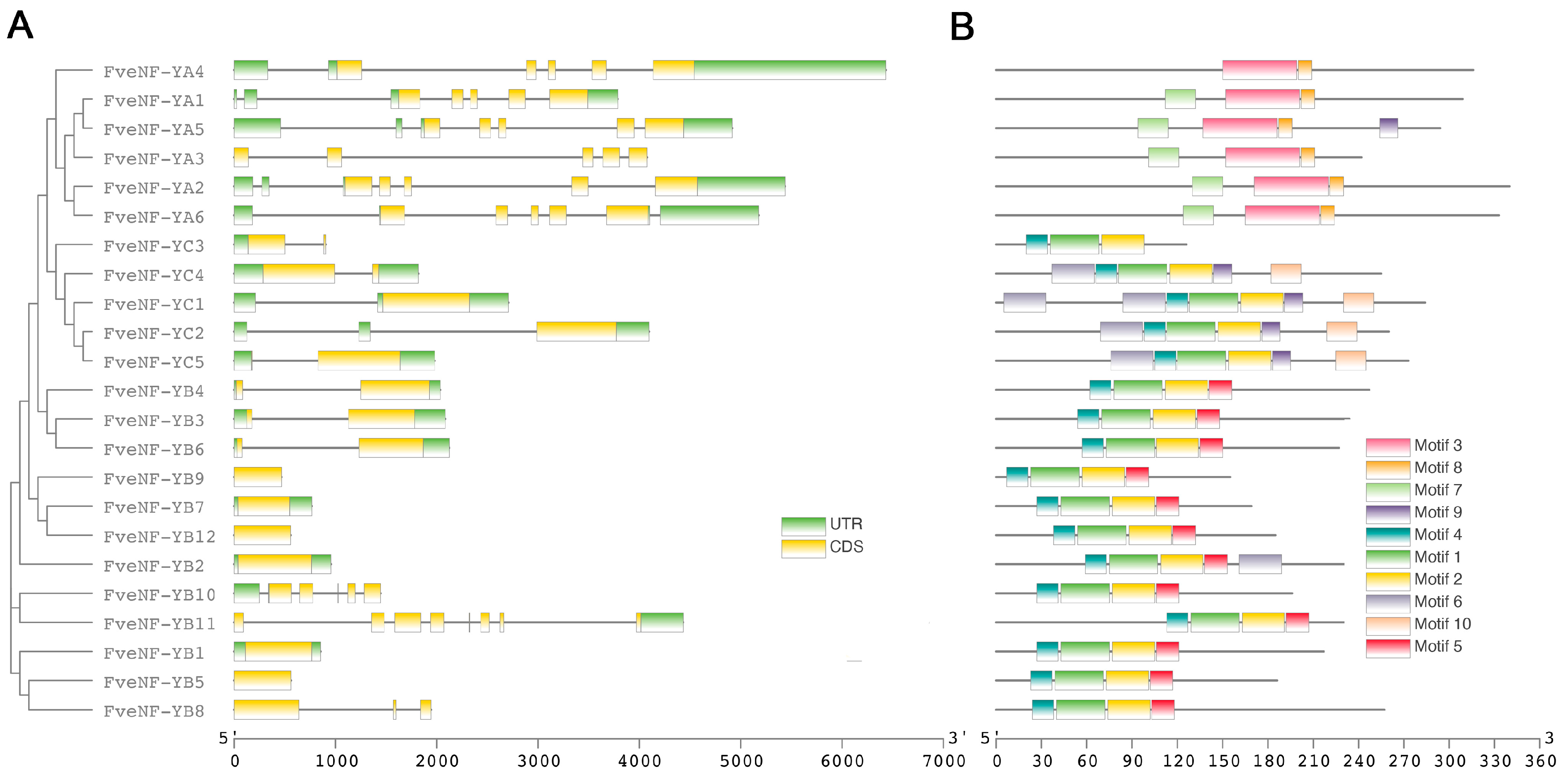
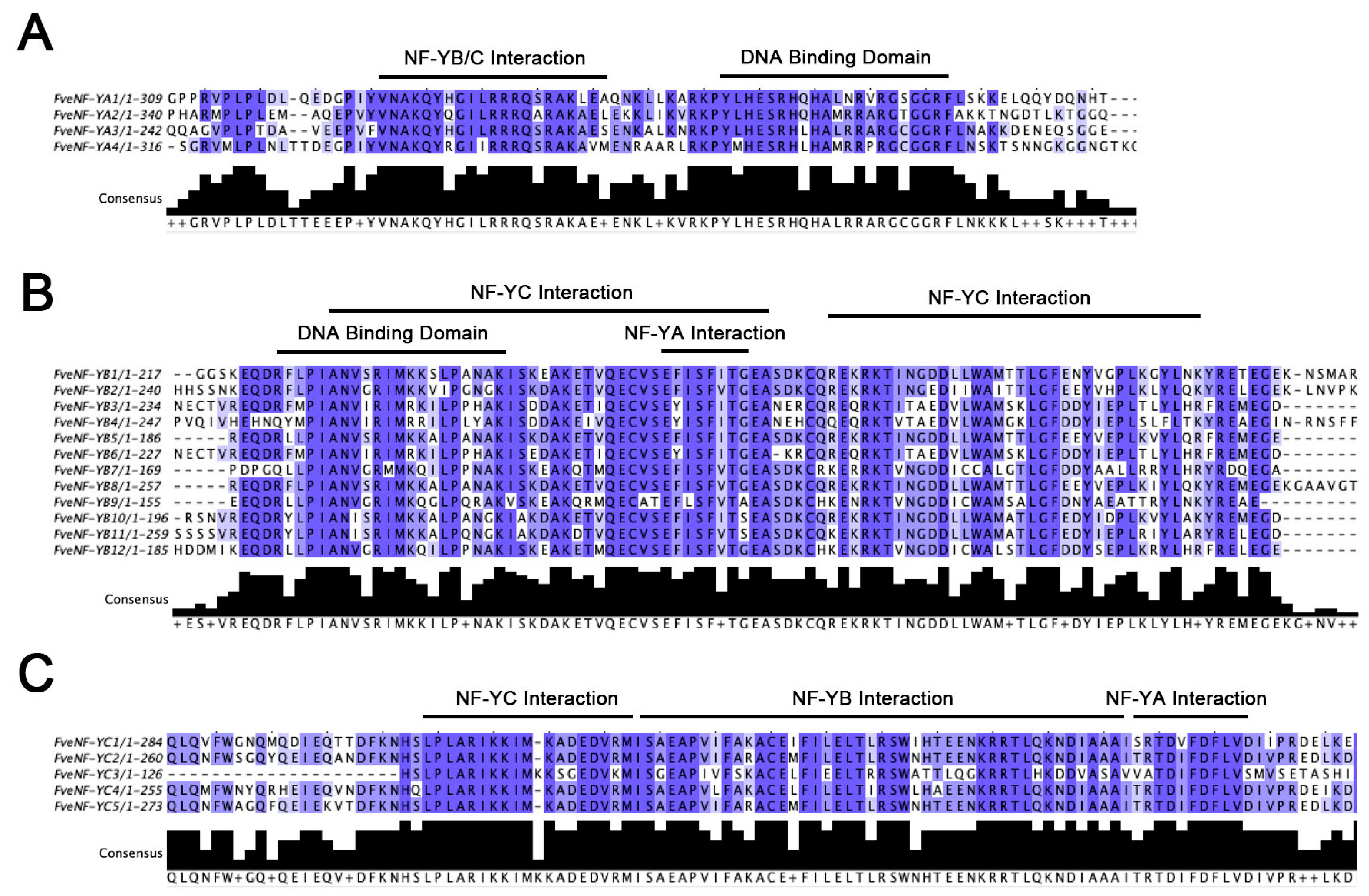


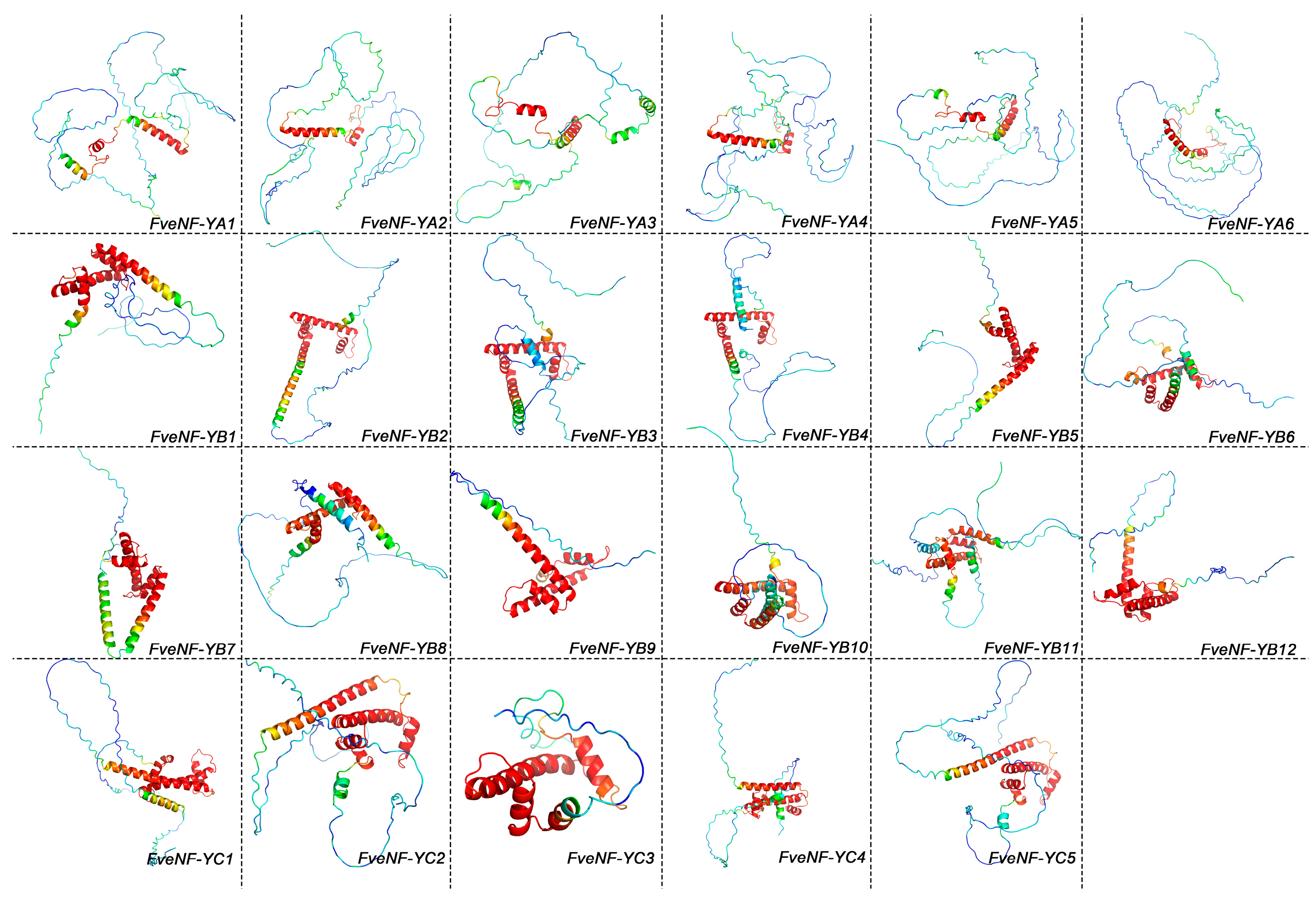
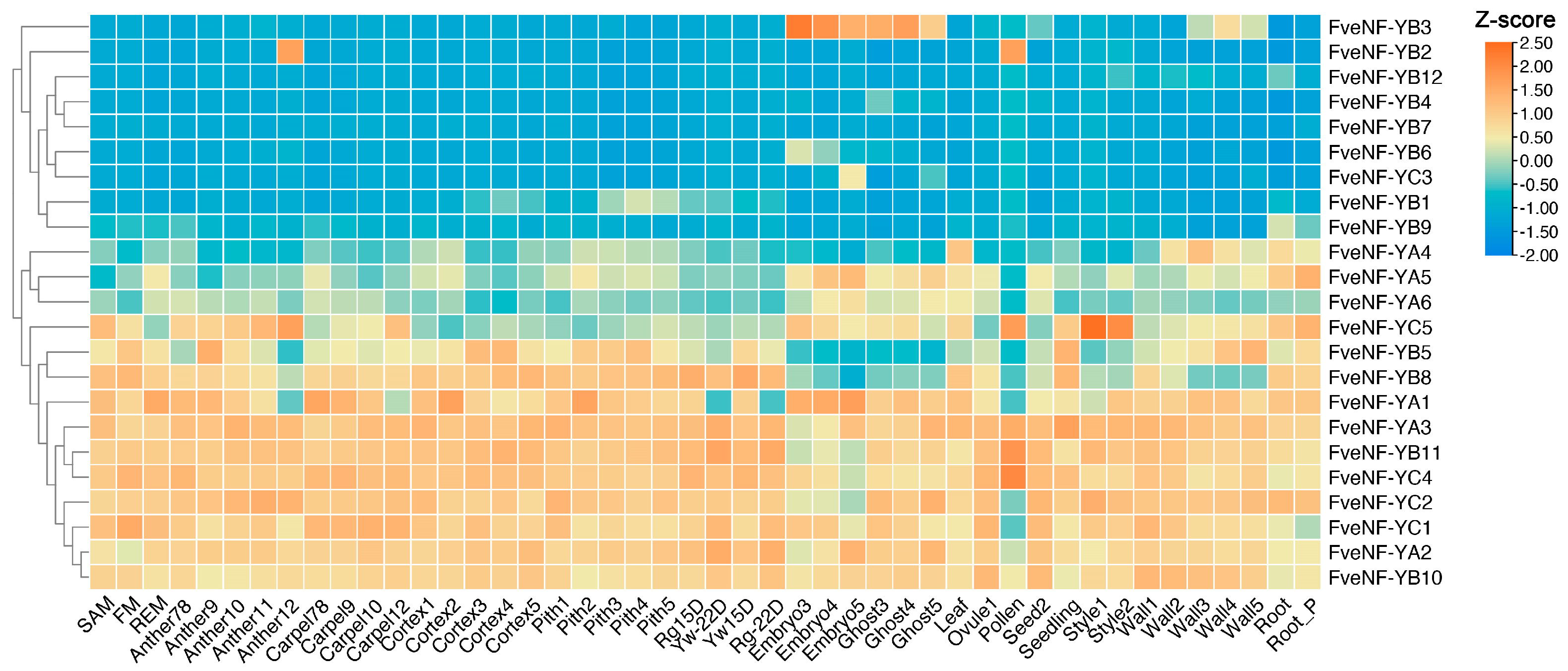
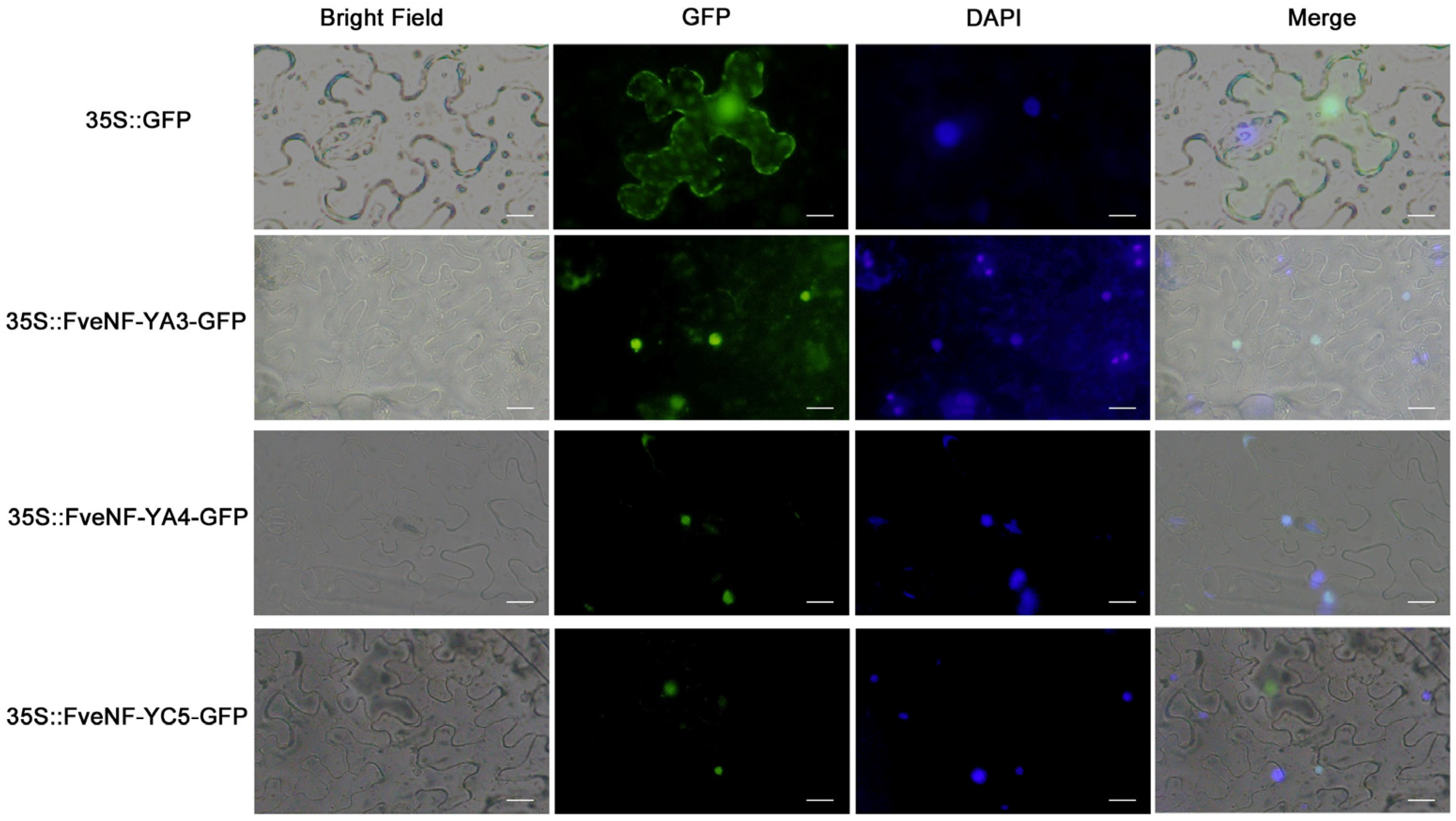
| Name | Gene ID | Chromosome Localization | CDS Length (bp) | Length (AA) | Mw (KD) | pI |
|---|---|---|---|---|---|---|
| FveNF-YA1 | FvH4_1g08160 | Fvb1:4317940-4321897− | 930 | 309 | 33.92 | 9.22 |
| FveNF-YA2 | FvH4_3g28780 | Fvb3:21759108-21764801− | 1023 | 340 | 37.23 | 7.8 |
| FveNF-YA3 | FvH4_3g10080 | Fvb3:5862158-5868309− | 729 | 242 | 27.06 | 6.63 |
| FveNF-YA4 | FvH4_6g20510 | Fvb6:14123785-14130216− | 951 | 316 | 34.90 | 9.55 |
| FveNF-YA5 | FvH4_6g34360 | Fvb6:27117419-27122335− | 885 | 294 | 32.52 | 9.51 |
| FveNF-YA6 | FvH4_7g01120 | Fvb7:1535820-1540996+ | 1002 | 333 | 36.46 | 9.46 |
| FveNF-YB1 | FvH4_1g22110 | Fvb1:14070688-14071541+ | 654 | 217 | 23.63 | 6.6 |
| FveNF-YB2 | FvH4_1g24590 | Fvb1:16424811-16425766+ | 723 | 240 | 27.48 | 6.48 |
| FveNF-YB3 | FvH4_3g00320 | Fvb3:190282-192366− | 705 | 234 | 25.78 | 5.86 |
| FveNF-YB4 | FvH4_3g29180 | Fvb3:22305284-22307319+ | 744 | 247 | 27.57 | 4.99 |
| FveNF-YB5 | FvH4_3g29360 | Fvb3:22455245-22455805− | 561 | 186 | 19.76 | 6.32 |
| FveNF-YB6 | FvH4_3g11540 | Fvb3:6810045-6812168− | 684 | 227 | 25.00 | 6.59 |
| FveNF-YB7 | FvH4_4g17750 | Fvb4:21739000-21739766− | 510 | 169 | 18.97 | 5.48 |
| FveNF-YB8 | FvH4_6g40600 | Fvb6:32072198-32074142− | 774 | 257 | 26.38 | 7.01 |
| FveNF-YB9 | FvH4_6g06220 | Fvb6:3560763-3561230− | 468 | 155 | 17.59 | 5.67 |
| FveNF-YB10 | FvH4_6g15260 | Fvb6:9505483-9509008+ | 591 | 196 | 21.19 | 7.63 |
| FveNF-YB11 | FvH4_7g20270 | Fvb7:16513966-16518574− | 780 | 259 | 28.48 | 6.91 |
| FveNF-YB12 | FvH4_c6g00060 | contig_6:45018-45575− | 558 | 185 | 21.00 | 6.12 |
| FveNF-YC1 | FvH4_3g14690 | Fvb3:9057069-9059776+ | 855 | 284 | 32.03 | 5.96 |
| FveNF-YC2 | FvH4_4g14750 | Fvb4:18408386-18412482+ | 783 | 260 | 28.91 | 5.81 |
| FveNF-YC3 | FvH4_5g01980 | Fvb5:1240614-1241518+ | 381 | 126 | 13.84 | 6.83 |
| FveNF-YC4 | FvH4_5g08391 | Fvb5:4870580-4875169− | 768 | 255 | 27.82 | 5.53 |
| FveNF-YC5 | FvH4_6g05540 | Fvb6:3147271-3150053+ | 822 | 273 | 30.42 | 6.18 |
| miRNA | Target | Expectation | miRNA Length | Target Start | Target End | Inhibition | Multiplicity |
|---|---|---|---|---|---|---|---|
| miRN53 | FveNF-YA1 | 4 | 22 | 21 | 42 | Cleavage | 1 |
| miRN4 | FveNF-YA3 | 5 | 21 | 350 | 370 | Cleavage | 1 |
| miR156c | FveNF-YB10 | 4.5 | 20 | 482 | 501 | Cleavage | 1 |
| miR156d | FveNF-YB10 | 4.5 | 20 | 483 | 501 | Cleavage | 1 |
| miRN21 | FveNF-YB11 | 4.5 | 21 | 528 | 548 | Translation | 1 |
| miRN22 | FveNF-YB11 | 4.5 | 21 | 528 | 548 | Translation | 1 |
| miRN23 | FveNF-YB11 | 4.5 | 21 | 528 | 548 | Translation | 1 |
| miR395a | FveNF-YB3 | 5 | 21 | 264 | 284 | Cleavage | 1 |
| miR395b | FveNF-YB3 | 5 | 21 | 264 | 284 | Cleavage | 1 |
| miR395c | FveNF-YB3 | 5 | 21 | 264 | 284 | Cleavage | 1 |
| miRN36 | FveNF-YB4 | 4 | 21 | 243 | 263 | Translation | 1 |
| miR396a | FveNF-YB4 | 5 | 21 | 442 | 462 | Cleavage | 1 |
| miR396b | FveNF-YB4 | 5 | 21 | 442 | 462 | Cleavage | 1 |
| miR396c | FveNF-YB4 | 5 | 21 | 442 | 462 | Cleavage | 1 |
| miR396d | FveNF-YB4 | 5 | 21 | 442 | 462 | Cleavage | 1 |
| miR482b | FveNF-YB5 | 4.5 | 22 | 505 | 526 | Cleavage | 1 |
| miR396a | FveNF-YB5 | 5 | 21 | 283 | 303 | Cleavage | 1 |
| miR396b | FveNF-YB5 | 5 | 21 | 283 | 303 | Cleavage | 1 |
| miR396c | FveNF-YB5 | 5 | 21 | 283 | 303 | Cleavage | 1 |
| miR396d | FveNF-YB5 | 5 | 21 | 283 | 303 | Cleavage | 1 |
| miR395a | FveNF-YB6 | 5 | 21 | 273 | 293 | Cleavage | 1 |
| miR395b | FveNF-YB6 | 5 | 21 | 273 | 293 | Cleavage | 1 |
| miR395c | FveNF-YB6 | 5 | 21 | 273 | 293 | Cleavage | 1 |
| miR395d | FveNF-YB6 | 5 | 20 | 585 | 604 | Cleavage | 1 |
| miRN53 | FveNF-YB8 | 4 | 22 | 578 | 599 | Cleavage | 1 |
| miR408 | FveNF-YB8 | 5 | 21 | 475 | 496 | Cleavage | 1 |
| miRN54 | FveNF-YB9 | 4.5 | 21 | 1 | 21 | Translation | 1 |
| miRN34 | FveNF-YC1 | 5 | 20 | 415 | 434 | Cleavage | 1 |
| miRN44 | FveNF-YC4 | 4 | 21 | 299 | 319 | Cleavage | 1 |
| miRN37 | FveNF-YC4 | 4.5 | 22 | 644 | 665 | Cleavage | 1 |
Disclaimer/Publisher’s Note: The statements, opinions and data contained in all publications are solely those of the individual author(s) and contributor(s) and not of MDPI and/or the editor(s). MDPI and/or the editor(s) disclaim responsibility for any injury to people or property resulting from any ideas, methods, instructions or products referred to in the content. |
© 2024 by the authors. Licensee MDPI, Basel, Switzerland. This article is an open access article distributed under the terms and conditions of the Creative Commons Attribution (CC BY) license (https://creativecommons.org/licenses/by/4.0/).
Share and Cite
Zhou, Y.; Gao, F.; Zhao, W.; Liu, T.; Wang, M. Genome-Wide Identification and Analysis of the Nuclear Factor Y Gene Family in the Woodland Strawberry Fragaria vesca. Horticulturae 2024, 10, 755. https://doi.org/10.3390/horticulturae10070755
Zhou Y, Gao F, Zhao W, Liu T, Wang M. Genome-Wide Identification and Analysis of the Nuclear Factor Y Gene Family in the Woodland Strawberry Fragaria vesca. Horticulturae. 2024; 10(7):755. https://doi.org/10.3390/horticulturae10070755
Chicago/Turabian StyleZhou, Yang, Feiyan Gao, Wenjie Zhao, Tianjia Liu, and Mengzhao Wang. 2024. "Genome-Wide Identification and Analysis of the Nuclear Factor Y Gene Family in the Woodland Strawberry Fragaria vesca" Horticulturae 10, no. 7: 755. https://doi.org/10.3390/horticulturae10070755
APA StyleZhou, Y., Gao, F., Zhao, W., Liu, T., & Wang, M. (2024). Genome-Wide Identification and Analysis of the Nuclear Factor Y Gene Family in the Woodland Strawberry Fragaria vesca. Horticulturae, 10(7), 755. https://doi.org/10.3390/horticulturae10070755







